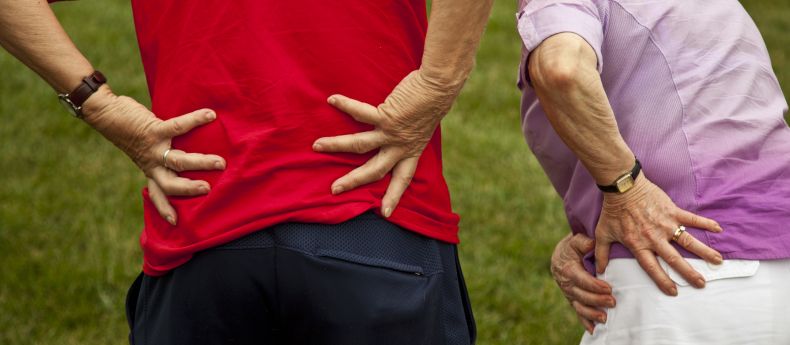
Guarding Against the Silent Killer: Osteoporosis
When thinking of osteoporosis, many see it as a challenge that only older people face. In fact, those who smoke or drink a lot of alcohol, do not exercise regularly, or diet improperly—regardless of their age—may already have hidden signs of declining bone health. Ultimately, osteoporosis has a few risk factors. These behaviors described above increase the likelihood of developing osteoporosis at a younger age. So how can you work to guard against osteoporosis in your daily life? In this article, I provide a brief overview of osteoporosis and direct you toward ways to assess your own risk factors as early as possible.
What is osteoporosis?
Osteoporosis is a disease in which one’s bones deteriorate, becoming thin and brittle and increasing the potential for fracture. The disease has been called the “silent killer” because early stages of the disease are difficult to detect and diagnose. Those with osteoporosis often receive a definitive diagnosis only after suffering one or multiple tell-tale bone fractures. Other diagnoses may come after the disease has had a significant effect on a person’s quality of life or has led to irreversible damage and disability. Fractures most commonly occur in the spine, hip, and wrist. Among these, hip fractures are usually the most serious and can lead to repeated fractures, permanent disability or even death. The clinical presentation of osteoporosis also includes aches and pains, skeletal deformities (such as a humpback), and reduced breathing capacity.
Evaluating your risk for osteoporosis
In China, men’s bone health peaks between the ages of 20 and 30; for women, between 30 and 40. After this, bone health begins to decline. Even though osteoporosis may be difficult to detect, it is important to know your risk factors in advance and take preventative measures, including timely examinations, to effectively predict and control your risk of developing the disease.
Hereditary and congenital risk factors include:
- Age
- Ethnic group (greatest risk among Caucasian and Asian populations)
- Gender (greater risk among women)
- Premature menopause (before age 45), including as a result of ovaryotomy
- Estrogen deficiency in women and testosterone deficiency in men
- Slight physique (BMI below 19)
- Family history of osteoporosis
- Previous history of bone fracture
- Having experienced a decrease in height (at least 4 cm)
Some risk factors related to lifestyle that you can control include:
- Calcium and Vitamin D deficiency
- Smoking
- Alcohol consumption (more than two drinks per day)
- Lack of exercise and activity
- Frequent or prolonged diarrhea
- Taking certain medications over a long period of time, including corticosteroids, GnRH antagonists (used to treat uterine myoma, endometriosis, prostate cancer etc.), Depo Provera, thyroxine, anti-convulsants, and certain drugs used in the treatment of cancer
Diagnosis and prevention of osteoporosis
Because osteoporosis is not easy to detect in its early stages, it is critical to know your family history and to recognize and treat osteoporosis as early on as possible. Based on the measurement by a bone densitometer of lumbar vertebrae, hip and 1/3 of the forearm, the World Health Organization’s international diagnostic criteria for osteoporosis is a T score of less than or equal to -2.5. Determining a patient’s bone density is a very important part of the diagnosis of osteoporosis. Bone density as measured by a bone densitometer (DXA) is the standard metric used today to evaluate bone health. It can be used to determine whether you have osteoporosis and a risk of fractures as well as to direct treatment strategies. Currently, United Family Healthcare (UFH) recommends those in ‘at-risk’ groups receive a bone density scan. Using the results of your scan, our bone density specialists and orthopedic physicians can diagnose and evaluate the development of osteoporosis and assess fracture risk. Men 50 years or older, menopausal and peri-menopausal women, people taking corticosteroids or other long-term medications outlined above, or people with other risk factors for osteoporosis should consider having a bone density exam as soon as possible. It you are considering treatment for osteoporosis or are currently undergoing a treatment regimen for osteoporosis, it is also recommended that you have a bone density exam to monitor your progress and treatment.
No matter what the results of your bone density exam, it is important to take care to prevent osteoporosis and avoid progression of the disease.
First, pay attention to what you eat. Eat lots of food rich in calcium, such as milk products, sea food, bean products, and leafy, green vegetables. In addition to getting adequate calcium, it is also important to get enough Vitamin D since it aids in the body’s absorption of calcium. Salty snacks, sugar, oily foods, and animal-based protein should only be eaten in small amounts because they interfere with calcium maintenance, as do diuretic beverages like coffee, strong tea, alcohol and carbonated drinks. Getting enough calcium through proper nutrition is the most crucial when we are young, as it is maintained in the body later in life.
Some people wrongly believe that osteoporosis is just a simple calcium deficiency, and they therefore go about blindly increasing their calcium intake. The reality is that whether you are a man or a woman, all people will experience a certain amount of bone loss once you reach middle age, usually about 0.5-1% per year. Bone density loss for women in the early stages of menopause can be as much as 2-3% per year. Therefore, it is important to consider reducing your risk factors for osteoporosis, even at a young age, (since the foundation for one’s bone health is laid as early as in the womb). Simply supplementing your calcium intake in middle age or older not only will not cure osteoporosis, it can also lead to other harmful health complications. If you think you may not be getting an adequate intake of calcium, please talk about possible calcium supplementation with your doctor.
Next, try to exercise on a regular basis. Exercise remains one of the best methods for improving one’s health. Exercise not only strengthens your heart and lung function and benefits the whole body and mind in various ways, it also has a beneficial effect on bone health. Additionally, exposure to some sunlight during outdoor exercise can improve the body’s synthesis of Vitamin D which, as mentioned, promotes the body’s absorption of calcium. Vigorous exercise (running, Tai Chi, sports) can increase muscle mass, improve balance, strengthen bone structure, and maintain normal bone metabolism.
Fractures are usually the outcome of osteoporosis, not only necessitating very expensive treatment, but also making life painful and difficult for those who suffer from it. If you have any of the risk factors discussed above, it is important to be especially careful in your daily life to prevent falls that could lead to fractures or more serious outcomes.
References:
1. The China Health Promotion Foundation. “White Paper China 2008: Osteoporosis, A Summary Statement,” 2008.
2.http://www.osteofound.org/fixed-risk-factors. International Osteoporosis Foundation. Accessed September 17, 2012.
Copyright United Family Healthcare 2014 All right reserved - 京卫网审[2014]第1927号 - 京ICP备13017554号-4




